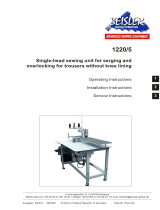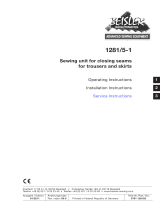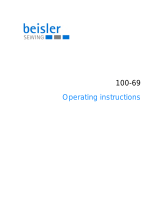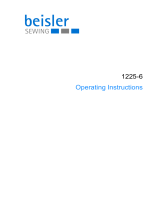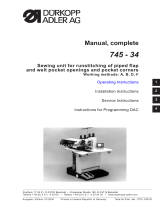Page is loading ...

1220-6/
1222-6
Manual, complete

All rights reserved.
Property of Dürkopp Adler AG and protected by copyright. Any reuse of these contents, including
extracts, is prohibited without the prior written approval of Dürkopp Adler AG.
Copyright © Dürkopp Adler AG 2019
IMPORTANT
READ CAREFULLY BEFORE USE
KEEP FOR FUTURE REFERENCE

General safety instructions
The non-observance of the following safety instructions can cause
bodily injuries or damages to the machine.
1. The machine must only be commissioned in full knowledge of the
instruction book and operated by persons with appropriate
training.
2. Before putting into service also read the safety rules and
instructions of the motor supplier.
3. The machine must be used only for the purpose intended. Use of
the machine without the safety devices is not permitted. Observe
all the relevant safety regulations.
4. When gauge parts are exchanged (e.g. needle, presser foot,
needle plate, feed dog and bobbin) when threading, when the
workplace is left, and during service work, the machine must be
disconnected from the mains by switching off the master switch or
disconnecting the mains plug.
5. Daily servicing work must be carried out only by appropriately
trained persons.
6. Repairs, conversion and special maintenance work must only be
carried out by technicians or persons with appropriate training.
7. For service or repair work on pneumatic systems, disconnect the
machine from the compressed air supply system (max. 7-10 bar).
Before disconnecting, reduce the pressure of the maintenance
unit.
Exceptions to this are only adjustments and functions checks
made by appropriately trained technicians.
8. Work on the electrical equipment must be carried out only by
electricians or appropriately trained persons.
9. Work on parts and systems under electric current is not permitted,
except as specified in regulations DIN VDE 0105.
10. Conversion or changes to the machine must be authorized by us
and made only in adherence to all safety regulations.
11. For repairs, only replacement parts approved by us must be used.
12. Commissioning of the sewing head is prohibited until such time
as the entire sewing unit is found to comply with EC directives.
It is absolutely necessary to respect
the safety instructions marked by these signs.
Danger of bodily injuries !
Please note also the general safety instructions.


Index Page:
Preface and general safety instructions
Part 1: Operating instructions
1. Description of product
1.1 Description of proper use ......................................... 3
1.2 Brief description ............................................... 3
1.3 Technical data ................................................ 4
2. Optional equipment ............................................ 5
3. Switching on - Switching off - Program stop
3.1 Switching on ................................................. 5
3.2 Switching off ................................................. 5
3.3 Program stop ................................................ 6
3.4 Restart after program stop ........................................ 6
4. Operation of the sewing machine head
4.1 General notes ................................................ 7
4.2 Recommended threads .......................................... 8
4.3 Removing /Putting on the fabric sliding sheet ............................. 9
5. Operation of the sewing unit
5.1 Feeding the trousers parts and starting the sewing process .................... 10
5.2 Adjusting the edge guide ......................................... 11
5.3 Adjusting the blowing air for the nozzles in the table top ...................... 12
5.4 Adjusting the guide blade ......................................... 12
6. Operation of the control
6.1 Operator terminal .............................................. 13
6.2 User interface ................................................ 14
6.2.1 Menu structure of the sewing and setting programs ......................... 14
6.3 Seam programs ...............................................16
6.4 Adjusting the control ............................................ 17
6.4.1 Altering seam-specific parameters.................................... 17
6.4.2 Altering global parameters ........................................ 19
6.4.3 Input - Output test.............................................. 20
6.4.4 Creation of seam programs ........................................ 21
6.4.5 Deleting a seam program ......................................... 22
6.4.6 Altering seam programs (Changing /Completing the sequence) .................. 22
7. Error messages .............................................. 23
1

Index: Page:
8. USB stick
8.1 General notes ................................................ 24
8.2 Formatting the USB stick ......................................... 24
8.3 Plugging the USB stick in the control .................................. 24
8.4 USB functions ................................................ 25
8.4.1 Storing data on the USB stick....................................... 27
8.4.2 Loading data from the USB stick ..................................... 27
8.4.3 Data comparison .............................................. 28
8.4.4 Deleting data from the USB stick..................................... 28
8.4.5 Loading software version from the USB stick ............................. 29
8.5 Removing the USB stick .......................................... 30
9. Maintenance
9.1 Cleaning and checking ........................................... 31
9.2 Oil lubrication ................................................ 33

1
1. Description of product
1.1 Description of proper use
1.2 Brief description
The 1220-6/1222-6 is a sewing unit which can properly be used for
sewing light to medium-weight material. Such material is, as a rule,
made of textile fibres. These materials are used in the garment
industry.
In general only dry material must be sewn on this machine. The
material must not contain any hard objects.
The seam is generally made with core thread, polyester fibre
or cotton threads.
The dimensions for needle and hook threads can be taken from the
table in chapter 4.2.
Before using any other threads it is necessary to estimate the
consequential dangers and to take the respective safety measures, if
required.
This sewing unit must only be installed and operated in dry and
well-kept rooms. If the sewing unit is used in other rooms, which are not
dry and well-kept, further measures to be agreed upon may become
necessary (see EN 60204-31 : 1999).
We, as a manufacturer of industrial sewing machines, assume that at
least semi-skilled operating personnel will be working on our products
so that all usual operations and, where applicable, their risks are
presumed to be known.
The Beisler 1220-6/1222-6 is a single-head sewing unit for serging and
overlocking of long skirt and trousers parts. The overlocking of the seat
and fly bow as well as of the trousers hem can be integrated.
All sewing unit components are mounted on a stand welded of square
steel tubes and controlled by a microprocessor system.
The sewing unit is operated via a control panel. Here it is possible to
call up various control programs, to define new programs and to check
all inlets and outlets for maintenance and repair purposes.
Machine head
– Pegasus two- or three-thread overlock machine
EX 5204-02/233-5/KS 371 (class 1220-6)
– Pegasus two- or three-thread overlock machine
EX 5204-24/445-8/Z054/PT (class 1222-6)
– Direct drive Efka Type DC 1500 /AB 221
– Microprocessor control, freely programmable
– Light barrier for recognizing the seam beginning and seam end for
the automatic sewing start and stop
– Height-adjustable edge guide for different material thicknesses
– External control panel Efka V850 with:
- Menu navigation
- Freely programmable parameters for “machine
parameters”, “Global parameters”, “Program sequences”
- Input and output tests
- 20 program storage locations
- up to 7 seam programs per program storage location
3

–
Vertical cutter with suction for overlocking and serging in one
operation
–
Chain separator with suction, programmable
–
Adjustable blowing nozzles in the table top for supporting the
material feed
–
Height-adjustable stand, infinitely variable from 850 mm to
1200 mm
–
Integrated stacking device
1.3 Technical data:
Machine head: Pegasus EX 5205-22/233-6KS (class 1220-6)
Pegasus EX 5204-24/445-8/Z054/PT (class 1222-6)
Stitch type: 504/505
Number of needles: 1
Needle system: B27
Needle size: Nm 80 to Nm 110
Threads: see chapter 4.2
Speed: 7500 r/min
Speed upon delivery: 7500 r/min
Stitch length: min. 1,0 mm
max. 5,0 mm
Seam width
Standard EX-head: 6 mm
Optional EX-head: 4 mm/5 mm
Material: Light to medium-weight material
Operating pressure: 6 bar
Air consumption: 20 NL per working cycle
Rated voltage: 1 x 230 V 50/60 HZ
Rated load: 0.9 kVA
Dimensions: 1500 x 900 x 1400 mm (L x W x H)
Working height: 850 ... 1200 mm (upper table top edge)
Weight: 120 kg
Noise level: LC = 81dB (A)
Workstation-specific emission value according to DIN 45635-48-B-1
Stitch length: 3 mm
Seam length: 1160 mm
Speed: 7000 r/min
Material: G1 DIN 23328 1 layer
Measuring point according
to DIN 4895 Part 1 X = 600 mm Y = 350 mm Z = 600 mm
x - axis = at right angles to the feeding direction
y - axis = main feeding direction
z - axis = height
4

1
5
2. Optional equipment
See annex
3. Switching on - Switching off - Program stop
3.1 Switching on
–
Switch on main switch 1 (turn in clockwise direction).
The control loads the machine program.
The basic display appears in the display of the control panel.
3.2 Switching off
–
Switch off main switch 1 (turn counter-clockwise).
1

3.3 Program stop
For an immediate stop in case of operating errors, needle breakage etc.
t
he safety system of the machine provides the following measures:
–
Press program stop switch 2 at the control panel.
The running operations are stopped immediately.
–
Turn main switch 1 counter-clockwise.
The sewing unit drops out immediately;
all movements of the sewing unit stop immediately.
3.4 Restart after program stop
Caution: Risk of injury!
Switch the main switch off.
Clear the fault only with the sewing unit switched off.
Only restart the sewing unit after the fault has been cleared.
–
Switch on main switch 1 (turn in clockwise direction).
–
Unlock the program stop switch.
The control loads the machine program.
The basic display appears in the display of the control panel.
The sewing unit is ready for operation again.
6
2 1
2

4. Operation of the sewing machine head
4.1 General notes
The operation of the sewing machine head (needle insertion, threading
of needle thread and hook thread etc.) is described in the attached
separate Pegasus operating instructions.
The instruction manual is included in the accessories of the sewing
unit.
Attention: Risk of injury!
Please read the operating instructions of the sewing machine head
carefully and observe all notes on safety.
7
1

4.2 Recommended threads
Needle system: B27
Recommended
needle size: Nm 80 for very thin material
Nm 90 for thin material
Nm 100 for medium-weight material
Nm 110 for heavy-weight material
High sewing security and good sewability are achieved with the
following core threads:
–
Two-ply polyester endless polyester core-spun
(e.g. Epic Poly-Poly, Rasant x, Saba C, ...)
–
Two-ply polyester endless cotton core-spun
(e.g. Frikka, Koban, Rasant, ...)
If these threads are not available, the polyester fibre or cotton threads
listed in the table can also be sewn.
Often two-ply core threads are offered by the thread manufacturers
with the same designation as three-ply polyester fibre threads
(3cyl.-spun).This causes uncertainty with regard to twisting and thread
thickness.
When in doubt, unravel the thread and check whether it is twisted 2- or
3-ply.
The label no. 120 on the thread reel of a core thread corresponds e.g.
to the thread size Nm 80/2 (see table values in brackets).
In case of monofilament threads you can use needle threads and hook
threads of the same thickness. The best results are achieved with soft
and elastic threads (software) of the thread thickness 130 Denier.
Recommended thread thicknesses:
Needle size Core thread Core thread
Nm
Needle thread Hook thread Needle thread Hook thread
Polyester Polyester Polyester Cotton
endless core-spun endless core-spun
Label No. Label No. Label No. Label No.
80
90 120 (Nm 80/2) 120 (Nm 80/2) 120 (Nm 80/2) 120 (Nm 80/2)
100 - 110 100 (Nm 65/2) 100 (Nm 65/2) 100 (Nm 65/2) 100 (Nm 65/2)
Needle size Polyester fibre thread Cotton thread
Nm (3cyl.-spun)
Needle thread Hook thread Needle thread Hook thread
80 Nm 120/3 Nm 120/3 Ne
B
60/3-80/3 Ne
B
60/3-80/3
90 Nm 80/3-120/3 Nm 80/3-120/3 Ne
B
50/3-70/3 Ne
B
50/3-70/3
100 - 110 Nm 70/3-100/3 Nm 70/3-100/3 Ne
B
40/3-60/3 Ne
B
40/3-60/3
8

4.3 Removing / Putting on the fabric sliding sheet
The fabric sliding sheet 2 is held in the gap of the table top by the
magnets 1.
The edge guide 3 is fastened on the fabric sliding sheet.
Removing the fabric sliding sheet
–
Carefully remove the edge guide 3 from the magnets in upward
direction.
–
Swivel the fabric sliding sheet aside.
The lower section of the sewing machine head is accessible now.
Putting on the fabric sliding sheet
–
Push the fabric sliding sheet into the gap of the table top and insert
in downward direction.
1
9
2 1
2 3

5. Operation of the sewing unit
5.1 Feeding the trousers parts and starting the sewing process
The overlock unit works semi-automatically.
The operator of the sewing unit has to do the following:
l call up the desired seam program;
l feed the material precisely;
l supervise the sewing process of the unit;
l remove the finished parts from the stacker.
Feeding the trousers part and starting the sewing process
1) Select the seam program at the control panel (see chapter 6.3).
2) Position the trousers part 1 from the right on the table top 2 and
under the contour guide 3.
ATTENTION!
As soon as the trousers part is pushed under the light barrier 5, the
sewing process starts automatically and the contour guide 3 lowers.
3) The trousers part is sewn.
4) As soon as the workpiece has left the light barrier 5, the seam
is finished and the stamp 4 lowers.
5) The contour guide 3 moves upward.
6) The stacker clamp moves to the front.
7) The stamp 4 moves upward again.
8) The trousers part is stacked with an air blast.
10
4 3 2 1
5 3

5.2 Adjusting the edge guide
The height-adjustable edge guide ensures a precise positioning of the
trousers part in front of the sewing head. The height of the edge guide
can be adjusted according to the thickness of the material to be sewn.
The draw roll 3 guarantees that the workpiece is precisely guided
under the sewing foot.
Adjusting the height of the edge guide
–
Draw dial 1 in the direction of arrow.
–
Set dial 1 on one of the four lock-in positions.
Position 1 = minimum height
Position 4 = maximum height
Fine adjustment of the height of the edge guide
–
Turn dial 2 correspondingly.
Setting the contact pressure of roller 4
–
Turn dial 3 in clockwise direction
The contact pressure of the roller is increased
–
Turn dial 3 counter-clockwise
The contact pressure of the roller is reduced
1
11
4 3 2 1

5.3 Adjusting the blowing air for the nozzles in the table top
The blowing nozzles 1 in the table top support the precise stacking of
the workpieces.
–
Set the intensity of the air blast by dial 2 at the control panel.
Turn the dial to the right = increased intensity of air blast
Turn the dial to the left = reduced intensity of air blast
5.4 Setting the guide blade
By means of the guide blade 1 the run of the workpiece can be
influenced.
–
Release lever 2.
–
Pull the guide blade 1 out or push it in.
–
Tighten lever 2.
12
2
1
2
1

6. Operation of the control
6.1 Operator terminal
For the input and output of data an operator terminal with an LCD
display and function keys is used.
Display Enter keys
Function keys
Keys 1 - 0
Program-
stop
Key Function
— Seam program 1 to program 20
Manual stacking
Menu selection/ Data storage
Set function auxiliary roller
Set function holding stamp
Set machine parameters
Key sewing stop in the seam
Input/ Output test
Sequence programming (S)
Program creation (Prg)
Set global parameters
Enter key
Select parameters / scroll
Alter parameter values
1
13

6.2 User interface
6.2.1 Menu structure of the sewing and setting programs
Switch on
main switch
Main screen
to
Call up sewing programs Menu selection Key F2
Manual
stacking
Key 3 Adjust auxiliary roller
Key 4 Adjust holding stamp
Key 5 Set machine parameters
Key 7 Sewing stop in the seam
Key 8 Input-Output test
Key 9 Set global parameters
Key 0 Program creation / Sequence creation
14

Calling up sewing programs
–
Switch the main switch on.
The control initializes.
The seam program previously used is loaded.
–
Press one of the keys “1, 2, 3, 4, 5, 6, 7, 8, 9, 0”.
The selected seam program is loaded.
Calling up the parameter menu
–
Switch the main switch on.
The control initializes.
The previously used program appears in the display.
–
Press key “P”.
The selection menu is called up.
–
Press one of the keys “1, 2, 3, 4, 5, 6, 7, 8, 9, 0”.
The display changes over to the corresponding function.
Manual stacking
When the seam program is selected:
–
Press key “F2”.
The stacker makes a stacking movement.
15
1

6.3 Seam programs
Designation of the individual seams:
1 = hem
2 = waistband
3 = fly seam or seat seam
4 = crotch seam
5 = side seam
The sewing unit is delivered with 5 standard seam programs:
Program Description
001 Sew crotch seam (4)
002 Sew side seam (5)
003 Sew hem (1) with joining crotch seam (4)
004 Sew hem (1) with joining side seam (5)
005 Sew hem (1) and seat seam (3) with
joining crotch seam (4)
A seam program in the display of the control panel
Program No. Seam No.
16
/
